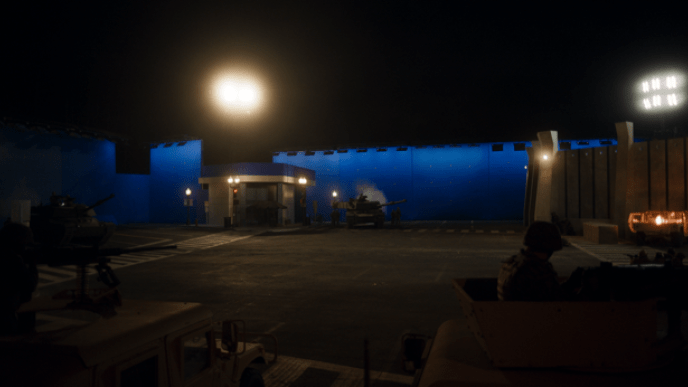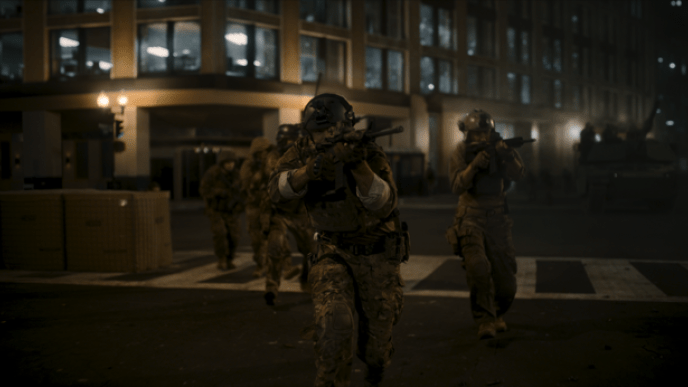
Civil War
Après le film d'horreur « Men », les studios de Framestore à Londres et à Mumbai ont à nouveau fait équipe avec le réalisateur Alex Garland pour son dernier long métrage qui donne à réfléchir - Civil War de A24.
Keeping it real
Framestore’s David Simpson once again served as Production VFX Supervisor, working closely with Garland and core creatives like DOP Rob Hardy and Production Designer Caty Maxey to achieve the film’s gritty, documentary-style aesthetic.
“Everything had to feel grounded and lived in,” says Simpson. “Anything remotely ‘Hollywood’ was immediately kicked into touch, and we focused instead on news and documentary footage. It made the research and reference-gathering stage pretty heavy going at times, but the aim was to create a realistic and utterly unsanitized view of war unfolding.”
Framestore’s key aim was to augment and extend the real-life action while enhancing those aspects that would not be safe or practical to accomplish on set or out on location. “The first rule was that, wherever possible, everything should be captured in camera,” says Simpson. Both Alex and Rob [Hardy, DOP] hew to a fluid, organic approach to filmmaking that allows them to capture those chance, serendipitous moments you only get when you’re filming on the day. This makes for a stronger, more dynamic piece of cinema, and it also means we had access to a wealth of amazing reference material in post.”
Street by street, block by block
Garland, Simpson and Hardy conducted recces of Washington DC to gauge the city and inform plans to find locations in Atlanta that might ‘double’ for the US capital. With no suitable stand-ins found, partial sets were constructed and the VFX team were charged with ‘building out’ the environments. “In those scenes involving close-quarters clashes you’re seeing a blend of CG and practical sets,” says Simpson. “Everything above the ground floor of those buildings has been built in CG.”
In keeping with the brief to create a living, breathing, immersive world for Civil War’s action, the Framestore team went above and beyond when it came to these environment builds. “I was walking home through London one evening and the city’s sheer lack of uniformity struck me,” says Simpson. “You notice how the offices are lit differently, the fractional changes in design from road to road and individual architectural quirks that break up any given street scene. This is what we sought to tap into: the fractional changes in lighting, building out the interiors of the offices so they weren’t just hollow CG shells but dotted with desk clutter, pot plants and air conditioning units. Your eye doesn’t necessarily register all this detail but your mind does, and it heightens both the believability of the VFX work and the storytelling itself, since you get a sense of the city’s sudden, Mary Celeste-esque abandonment.” The team created over 3,700 buildings, replete with over half a million items of office furniture.
The success of these showcase moments was such that the VFX work expanded ambitiously outwards to the point where Framestore had effectively built a fully-CG Washington DC, complete with over 64,000 flickering street lamps, 887 miles of roads and over 1,1000 functional traffic lights. This city was then dotted with gunfire, digital crowds, flames and columns of smoke to highlight the skirmishes and clashes happening at points around the city. This work helped give a sense of scope and expanse, amplifying the story by highlighting how the drama extended far beyond what was happening to the film’s main cast. Rendering the whole city in CG also had some more practical creative benefits, as Simpson explains: “building Washington ourselves meant we could achieve shots that simply wouldn’t be possible or practical in real life,” he says. “The US Secret Service are obviously somewhat cagey about people flying helicopters close to the White House, for example - if we wanted to do that we’d need an armed agent onboard, and there’s no way we could have gotten as close as we did. There’s also the issue of the Lincoln Memorial, which, for practical and ethical reasons, we couldn’t blow up.”




The devil's in the detail
If the photoreal cityscapes and internal design of office blocks added to the worldbuilding, so, too, did the finer details. “Everything was based on real-life footage,” explains Simpson. “We had de facto casting sessions for our explosions, using newsreels, citizen journalism and footage from weapons tests. We also needed to know what kind of damage these explosions would do, to streets, to buildings and, most harrowingly, to people. The aim was to strip away any sense of showiness, rendering the reality of war in all its stark, horrifying detail.”
Debuting at SXSW, Civil War has already been hailed as one of the year’s most startling, visceral and necessary films. Framestore was proud to be an early-doors collaborator on the feature, identifying and deploying the best techniques, technologies and methodologies to achieve Alex Garland’s distinctive and uncompromising vision and delivering some 1,000 VFX shots via its studios in London and Mumbai.


Facts and stats
It took a team of 175 artists 406 days to deliver Civil War’s intricate VFX work. During this time, the team created:
- 13 miles of Washington
- 75 landmarks
- 887 miles of road
- 3,736 buildings
- 64,191 street lamps
- 1,160 traffic lights
- 519,066 items of office furniture
- 17,851 trees

How Civil War Destroyed Washington D.C. in its Deafening, Violent Climax - GQ
How They Pulled Off the Ending to 'Civil War' - The New York Times
Civil War: David Simpson - Production VFX Supervisor - Art of VFX
'Civil War' VFX Supervisor Explains How They Pulled Off the Battle in Washington D.C. - The Wrap
An Urgent Dispatch from The Future Front Lines of Civil War - VFX Voice
Civil War: Chronicling Chaos - American Cinematographer





